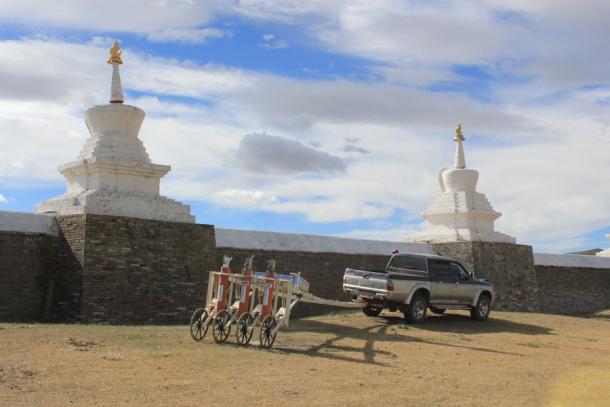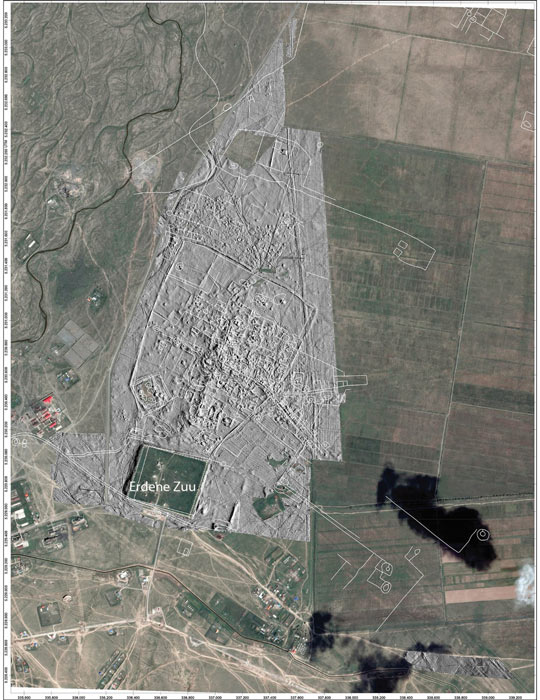
Lost Mongol Capital of Karakorum Mapped Properly for the First Time
The city of Karakorum, the 13th century capital of the great Mongol empire was established initially as a camp by Genghis Khan in the Orkhon Valley in 1220, and would be developed by his son and successor Ögödei and its construction finally finished in the middle of the 13th century. But like the trajectory of history’s largest land empire, it fell into disrepair and abandon by the 15th century, and its location was lost, only kept alive by written record. Now, a team of archaeologists, employing advanced geophysical methods have mapped the lost capital, and presented their findings in the journal Antiquity, published by the Cambridge University Press.
SQUID and Other Technological Methods to Reconstruct Karakorum
Using a technology called Superconducting Quantum Interface Device, or SQUID, they conducted an aerial survey of 465 hectares of the site, 300 kms south-west of the current Mongolian capital, Ulaanbaatar. This site, and knowledge of the ancient capital, had been rediscovered in 1889, but due to the absence of the current technological standards, very little archaeological work had been conducted at the site, leading to a very poor understanding of the capital of the Mongol Empire. Thanks to the work of the current team, we can now revisit our understanding of Karakorum in much more depth, reports The Art Newspaper.
- The Golden Horde and the Mongol Mission to Conquer Europe
- Khutulun: The Undefeated Bad-Ass Mongolian Warrior Princess

The vehicle-drawn SQUID measurement system at work in front of the Buddhist monastery of Erdene Zuu, founded in 1586 and probably erected on top of the former palace area of Karakorum. (J. Bemmann / Antiquity Publications Ltd)
“The great gain from our project is that we can now view the plan of the abandoned city in enormous detail, both above and below ground,” says Jan Bemmann, a professor in the Institute for Archaeology and Anthropology at the University of Bonn, Germany, and the research paper’s lead author. “Geophysical prospecting shows us where production sites are located, where larger brick-built buildings stood, where roads ran that are no longer visible in the terrain today, to name just a few examples.”
The other ignored subject of previous archaeological work here has been the absence of focus on another phenomena, namely ‘steppe urbanism’, as the authors write in their introductory passage. This refers to the construction of the city of Karakorum, with its many neighborhoods and subdivisions (it was, after all, a walled city), in the middle of flat and unforested desert-like grasslands.

The SQUID measuring system in operation on the grasslands of today at Karakorum (J. Bemmann / Antiquity Publications Ltd)
Magnetic and topographic surveys were also carried out on the surrounding landscape and the city itself, to reveal “road networks and areas of variable occupation density” that helped them better understand this important commercial hub of yesteryear. The overarching result: the researchers have drawn on these advanced geophysical methods to publish a detailed and comprehensive map of the capital, reports The Smithsonian. The technology ‘measures topography and underground magnetic fields to create a map of unexcavated remains below the surface’, according to Heritage Daily. The authors add that the region is also conducive to carrying out remote sensing.
- Genghis Khan: What Transformed Temujin Borjigin into an Unstoppable Force Bent on World Domination?
- Australian Archaeologists Identify Genghis Khan’s Lost Winter Camp
Combination of the new topographic map (grey shading), Radloff's (1892) map (white lines) and present-day aerial image. The new topographic map is based on high-resolution altitude data gathered with the SQUID system, alongside the magnetic measurements. The outlines of walls and buildings have been digitised from Radloff's map. The topographic map and aerial image are georeferenced precisely, Radloff's map approximately. (Aerial image © Esri, DigitalGlobe, GeoEye, Earthstar Geographics, CNES/Airbus DS, USDA, USGS, AeroGRID, IGN, and the GIS User Community; graphic by S. Linzen / Antiquity Publications Ltd).
The Historical Background to Karakorum
In 1220, Genghis Khan strategically established a camp of yurts in the Orkhon Valley, where it transitions into more level pastures. Khan, whose greatest strength lay in uniting the many nomadic tribes of Northeast Asia through highly advanced military and tactical prowess, died in 1227, but Ögödei, his successor, continued his father’s work. A lavish palace was constructed over the next couple of generations, where they played host to foreign diplomats, traders, Chinese artisans, merchants and travelers along the historical Silk Road.
Twice a year, the khan (the title given to the supreme leader) would come and stay in the city and the palace, for an extended period, and the elite of the empire were encouraged to build their own homes near the imperial palace. Prisoners of war and craftspeople of renown, who were captured by the brutal marauding armies of the Mongol Empire, were placed in the walled interiors of the city, either providing their services in the fields of their craft, or forced to work in the military, or as bonded labor.
Karakorum fell into ruin after 200 odd years, as infighting amongst various powerful entities and Genghis’ successors led to the disintegration of the great empire. Karakorum remained in the popular imagination of future generations and found frequent mentions in European, Persian, and Chinese sources, but its exact location remained lost until 1889, when it was rediscovered by Siberian explorer, Turkologist, and archaeologist, Nikolai Yadrintsev.

Kharkhorin Erdene Zuu Monastery is built near the ancient site, but the boundaries of the lost city are now known to extend far beyond the existing wall boundary. (Kokhanchikov / Adobe Stock)
Findings and Moving Forward
“The discovery that the city extends far beyond the city wall, which is more a demarcation than a fortification, give us a hint for a different understanding, a different concept of city,” Bemmann continues. “Based on a renewed analysis of written sources, intensive surveys and data from remote sensing, we have come to the preliminary conclusion that the Mongolian khans built not only a capital city, but also a network of residences, supply settlements and production sites. Therefore, we are not only talking about an imperial city, but about an imperial valley.”
As occurs with older settlements, layers of periodical construction enforce themselves into the many layers of the soil that form over hundreds and thousands of years. In this settlement, the central parts of the city were found to be distinguishable by large volumes of settlement layers, covered with different types of vegetation and loamy soil. The latter functions as an indicator of underlying brick-structures, which helped first confirm the veracity of the site. This center is roughly 13% of the walled area.
Interestingly, since the Mongols are nomadic tribes, constructing permanent residences was clearly not a priority. In fact, only the prisoners of war, craftspeople, and other laborers were provided with permanent residences of the city, leaving about 40% of the space on the inner side of the wall empty.
“The results of this mapping project will allow us to plan future excavations more precisely and to promote the protection of the Unesco World Heritage Site even more carefully and comprehensively,” Bemmann concludes.
The full report is available from Antiquity Publications Ltd, https://doi.org/10.15184/aqy.2021.153
Top image: Erdene Zuu Monastery in Karakorum, ancient capital of Mongolia Source: Christopher Meder / Adobe Stock
By Sahir Pandey
References
Bemmann, J., Linzen, S., Reichert, S., & Munkhbayar, L. 2021. Mapping Karakorum, the capital of the Mongol Empire. Antiquity. Available at: https://doi.org/10.15184/aqy.2021.153.
McGreevy, N. 2021. Archaeologists Map Ruins of Karakorum, Capital of the Mongol Empire, for the First Time. Available at: https://www.smithsonianmag.com/smart-news/archaeologists-map-capital-of-mongolian-empire-for-the-first-time-180979007/.
Shaw, G. 2021. Archaeologists have mapped the ancient capital of the Mongolian Empire. Available at: https://www.theartnewspaper.com/2021/11/04/archaeologists-have-mapped-the-ancient-capital-of-the-mongolian-empire.
















